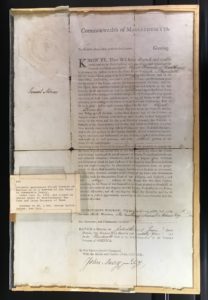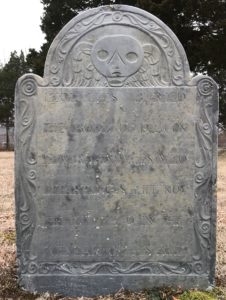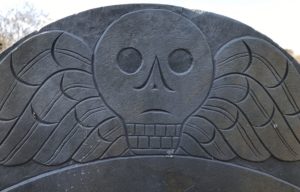Excitement rippled through Eastham with the recent rediscovery in the archives of the historical society of a document signed by Samuel Adams. Adams, born in 1722, was one of the architects of the Revolution, and, in 1794, succeeded John Hancock as governor of Massachusetts. On June 16, 1795, he affixed his signature to the document appointing Elijah Knowles justice of the peace. The document was donated to the Eastham Historical Society in 1979 by Mr. and Mrs. George C. Myrick, then of Delmar, N.Y.

The roots of the Knowles and Myrick (or Merrick) families are deeply intertwined in Eastham, dating to the 1640s and 1650s. In 1803, Jesse Myrick (1782-1872) married Elizabeth Knowles (1784-1855), one of seven children of Elijah Knowles and Rebecca Harding. Jesse and Elizabeth had 11 children. Two years after the birth of their youngest child, Elisha, they left Eastham and joined the Shaker community in Harvard, Mass.
The Shakers proselytized throughout New England in the 1820s and 1830s, sending missionaries to Methodist camp meetings, or outdoor worship gatherings, including one in South Wellfleet in 1819 and later on Bound Brook Island. From 1828 to 1863, camp meetings were held at Eastham’s 10-acre Millennium Grove. The Myricks were, no doubt, moved to join the Shakers after hearing members at an early meeting.
All of the Myrick children and their parents, with the exception of Elisha, are buried in Harvard’s Shaker Cemetery. They were not the only Myrick relatives to trade Eastham for the industrious, entrepreneurial, celibate community founded in 1792. Buried with them are Jesse’s brother Isaac; Elizabeth’s unmarried sister Lucy Knowles; her married sister Anna Knowles Mayo and husband Joseph Mayo; and Betsy Doane Knowles (1802-1882), who left Eastham after the death of her husband, Henry Mayo Knowles, in 1854.
The Eastham family of Godfrey Sparrow (1805-1865) also joined the Shaker community. Godfrey’s wife, Mercy Higgins, had died in 1833 and was buried in the Orleans Cemetery. It is likely that, in 1834, Godfrey took at least four of his motherless children to Harvard, where he is buried with his three daughters. His son, Warren, renounced the Shakers in 1862.
Elijah Myrick, the second youngest of Jesse and Elizabeth’s children, was an esteemed member of the Shaker community, patenting a metal chimney cap, bottling and marketing medicinal spring water, and eventually becoming a prominent elder. In Elijah’s obituary, his younger brother Elisha was described as “one of the world’s people.” Elisha renounced Shakerism in 1859 at age 33, and, in 1861, married Sarah Godbold, with whom he had two sons.

Elisha had worked in the Shakers’ lucrative medicinal herb industry. Their medical practices paralleled the botanical remedies developed by Samuel Thomson, who had visited Eastham with his herbal health care system during the 1816 epidemic. Two of Elisha’s sisters, Susan and Anna, became Shaker physicians. Elisha Myrick later established himself as a druggist, associated with the Boston firm Cheney & Myrick, whose specialty was pressed herbs and hops. He lived in Chelsea and later in Melrose, where he died in 1892, having “endeared himself to all by his genial and social qualities.”
In Eastham, the family of Elijah Knowles was prominent and respected. His grandfather, Deacon Edward Knowles (1671-1740), was a tanner and served as selectman and town treasurer. Edward Knowles Jr. (1713-1799) followed in his footsteps, serving as deacon of the north meetinghouse, as town clerk, and, for two terms, as treasurer. It is said that he was among the first to manufacture salt by solar evaporation in Eastham. Married three times, Edward Knowles and his first wife, Ann Doane Knowles — the widow of a Knowles cousin — were the parents of Elijah, born in 1747.
Elijah’s short life was full of honors. Continuing a family tradition of community service, he was appointed in 1790 to a committee tasked with drafting a petition to the General Court to regulate fisheries. He served in the General Court from 1785 to 1795 and was Eastham town treasurer and clerk for several years until his death. In May 1795, he helped complete a survey of the town that now resides in the state archives. That same year, he was appointed justice of the peace by Gov. Adams.

Just months later, Elijah Knowles died at age 48. In compiling his 1844 history of Eastham, Wellfleet, and Orleans, the Rev. Enoch Pratt included a notice from town records on Elijah Knowles’s death: “He had represented the town nine years in succession in the General Court and was one of the most distinguished men of the town, being often employed in other public offices of trust and importance. His death was deeply lamented by all who knew him.” Elijah Knowles is buried, with his parents and his son Harding, at the Bridge Road Cemetery, the site of the north meetinghouse from 1720 to 1830. His grandfather, Deacon Edward Knowles, rests in Cove Burying Ground.
Editor’s note: Amy McGuiggan’s article “The Mysterious Cape Cod Epidemic of 1816” was published in our issue of April 30, 2020.



